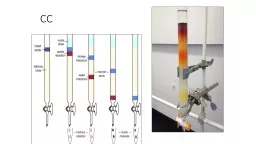

1 Adsorption chromatography 2 Partition chromatography 3 Ion exchange chromatography 4 Gel filtration chromatography 5 Affinity chromatography Thin layer chromatography TLC is a method for ID: 781465
Download The PPT/PDF document "CC Classification according to the force..." is the property of its rightful owner. Permission is granted to download and print the materials on this web site for personal, non-commercial use only, and to display it on your personal computer provided you do not modify the materials and that you retain all copyright notices contained in the materials. By downloading content from our website, you accept the terms of this agreement.
Slide1
CC
Slide2Classification according to the force of separation:
1- Adsorption chromatography.2- Partition chromatography.
3- Ion exchange chromatography.
4- Gel filtration chromatography.
5- Affinity chromatography.
Slide3Thin layer chromatography (TLC)
is a method for identifying substances and testing the purity of compounds.
TLC is a useful technique because it is relatively
quick
and requires
small quantities
of material.
Slide4Separations in TLC involve distributing a mixture of two or more substances between a
stationary phase and a mobile phase.
The stationary phase:
is a thin layer of adsorbent (usually silica gel or alumina) coated on a plate.
The mobile phase:
is a developing liquid which travels up the stationary phase, carrying the samples with it.
Components of the samples will separate on the stationary phase according to
how much they adsorb on the stationary phase versus how much they dissolve in the mobile phase.
Slide5Thin Layer Chromatography (TLC)
Slide6Slide7TLC
Slide8Preparing the Chamber
To a jar with a tight-fitting lid add enough of the appropriate developing liquid so that it is 0.5 to 1 cm deep in the bottom of the jar.
Close the jar tightly, and let it stand for about 30 minutes so that the atmosphere in the jar becomes saturated with solvent.
Slide9Preparing the Plates for Development
With a pencil, etch two small notches into the adsorbent about 2 cm from the bottom of the plate.
The notches should be on the edges of the plate, and each notch should be the same distance up from the bottom of the plate.
The notches must be farther from the bottom of the plate than the depth of the solvent in the jar.
Using a drawn-out capillary tube, spot the samples on the plate so that they line up with the notches you etched.
Slide10Question: What is wrong with the plate shown below?